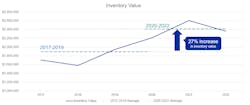GHX releases data and perspective on booming cost of inventory control
Between 2020 and 2022, there has been a 27% increase in inventory value.
According to Lee Smith, DHA, MBA, BSN, RNFA, VP, Chief Nursing Officer, Syft, a GHX company, “I think supply chain leaders are really struggling to manage the additional inventory resulting from the pandemic. Challenges include finding more physical space to store the additional inventory and ensuring that it is properly rotated while managing expiry and backorder issues. Supply chain leaders are trying to maintain a budget neutral inventory by lowering PAR values where appropriate or reducing or even eliminating obsolete or seldom used inventory. All this must be performed with the same or reduced staffing.”
Pressure on hospital supply chain teams to streamline operations and eliminate waste is higher than ever as hospitals carry more inventory to avoid stockouts. Utilizing an inventory management system with artificial intelligence (AI) and machine learning (ML) capabilities can enable healthcare leaders to better forecast supply needs, understand supply spend, consumption and variance, and reduce unnecessary waste while optimizing standardization opportunities and surgical cost savings.
Top benefits for healthcare leaders using an AI-enhanced inventory management system:
• Visibility, traceability, and accuracy of products from dock-to-doc
• Automated alerts for expired/soon-to-be-expired and recalled items
• Insight into supply availability and demand for improved purchasing decisions of inventory
Inventory value is primarily calculated with hospital pricing data (e.g., from purchase order history) and supplemented as needed with Syft average price estimates.

